Drop-in cartridge conversion cylinders offer users the ability to shoot modern cartridges in percussion or cap-and-ball revolvers without modifications to the revolver. While it might seem similar to buying an aftermarket magazine for a semiautomatic pistol, it is more complicated with revolvers. What’s the expression? Timing is everything.
A cartridge-converter cylinder makes a cap-and-ball revolver more versatile and essentially changes it into a cartridge revolver. Loading cowboy cartridges is faster with a conversion cylinder than loading loose powder, wads, and balls into a percussion cylinder, but loading is still slower than a traditional single-action revolver. We wanted to see how easy it was to use a conversion cylinder, as well as the accuracy they could deliver. We also wanted to know how compatible the cylinders were among revolvers of the same manufacturer.
Two popular cartridge conversion cylinders are from Taylor’s & Co. and Kirst Konverter LLC. (KirstKonverter.com). Howell Arms provides the raw material for Taylor’s conversion cylinder, and Taylor’s cuts and blues the cylinders. The idea behind these cylinders is a shooter can field-strip a percussion revolver, remove the percussion cylinder, and install the cartridge conversion cylinder to shoot cartridges.
All new percussion revolvers are made by either Pietta or Uberti, and though the guns may look similar, they differ dimensionally. Specifications also vary between manufacturers. Parts from a Pietta Remington 1858 are not compatible with a Uberti Remington 1858. This means a conversion cylinder needs to be matched to the manufacturer of the revolver.
To learn the utility of the conversion cylinders, we used two 44-caliber revolvers, both Remington 1858 clones made by Uberti. One was a new Uberti Remington 1858 percussion revolver with the traditional 8-inch barrel, and the second was a new Taylor’s 5.5-inch barrel Remington 1858, also made by Uberti. We then sourced conversion cylinders in 45 Long Colt from Taylor’s and Kirst Konverter. We did not test the revolvers using the percussion cylinders; we only evaluated the conversion cylinders.
Though the revolvers are 44 caliber, their bore diameters are actually 0.451 inch and require a 0.452- to .454-inch-diameter bullet. This is the same bore diameter for a cartridge revolver chambered for 45 Long Colt, so good accuracy can be achieved using 45 Long Colt ammo. (As a side note, 36-caliber percussion revolvers have a larger bore diameter than the 38 Special cartridges used in conversion cylinders. Do not expect stellar accuracy using a 38 Special cartridge conversion cylinder for this reason.)
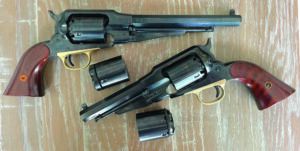
A few more caveats need to be mentioned before trying a conversion cylinder. Don’t use a conversion cylinder in a brass-frame replica nor an original percussion revolver because you will end up creating an IED that could destroy a gun or cause you and bystanders harm. Also, only use lead-bullet cowboy ammo with a conversion cylinder. This ammo is loaded to low velocities and low pressures and is perfectly safe in a new percussion revolver using a cartridge conversion cylinder. Also, do not use jacketed ammo with conversion cylinders. While these old percussion revolver designs use modern steel, the basic design is not strong enough to withstand the pressure from modern cartridges loaded with jacketed bullets.
Both the Taylor’s and Kirst conversion cylinders come in two parts, the cylinder and a back plate. The backplate is removed to load cartridges in the cylinder, and once loaded, the backplate is reinstalled. The complete cylinder is then installed in the revolver. After the cartridges are fired, the cylinder is removed, cases ejected, and then reloaded. The revolver, in essence, is field stripped each time the cylinder is loaded and emptied. Where the Kirst and Taylor’s cylinders differ is in the firing-pin design.
The Taylor’s back plate features six free-floating firing pins, one for each cylinder. This is similar to the set up on a percussion cylinder with six nipples, one for each chamber. The outer edge of the backplate is checkered for a sure grip when removing it from the cylinder. On the back of each conversion cylinder there is a stamp with either a “P” or a “U,” designating Pietta or Uberti, respectively. A small post protrudes from the back of the cylinder and aligns with a hole in the backplate. This ensures the backplate attaches the same way each time. The pieces are a tight fit. The rachet for the revolver’s hand or pawl is built into the backplate. Small notches are cut in the cylinder so you can see if an empty case or a round is loaded in the chamber. There are no safety notches on the cylinder, and Taylor’s recommends resting the hammer on an empty chamber if you plan on carrying the gun loaded.
The Kirst cylinder is named the Equalizer and the backplate is called a Konverter Ring, which features one spring-loaded firing pin at the 12 o’clock position. At the 6 o’clock position is a flat edge that fits into the cylinder window of the revolver’s frame. The ring or backplate does not rotate; it stays fixed. The racket is machined into a post that extends from the back of the cylinder. There is an open space between the ring and cylinder so you can see if a round is in the chamber. The cylinder has five chambers. You may recognize the Kirst Equalizer from the movie Pale Rider.
Kirst makes a ring with a loading gate, but you need to modify the frame of the revolver by cutting a loading port, an action that’s beyond the scope of this test. An ejector set is also available, and this replaces the Remington’s cylinder pin with a pin that has an ejector mounted to it. We did not test the gated cylinder or ejector set because permanent modifications must be made to the revolver.
The Taylor’s and Kirst conversion cylinders were nicely machined with a blued finish.
Both Remington 1858 revolvers operate the same way. They are single-action revolvers with fixed sights. To field-strip the Remington, unlatch the loading lever to allow the cylinder pin to be pulled to from the cylinder. The cylinder pin is captured by the loading lever so it can’t be dropped or lost. The cylinder is removed and replaced from the right side of the frame. We cocked the hammers numerous times with the percussion cylinder installed and controlled the forward movement of the hammer. You don’t want to dry fire on the nipples nor either of the conversion cylinders. The timing for both revolvers was fine with the percussion cylinder, and no ring formed on the cylinder even after extensive cocking of the pistols.
Ammo used consisted of 45 Long Colt ammo from Magtech and Sellier & Bellot. We also used 45 Schofield ammo, which is a shorter version of the 45 Long Colt. This ammo was made by Choice Performance. All of this ammunition is loaded with lead bullets to low velocities and is widely used by those participating in Cowboy Action Shooting, hence the reason they are generally called cowboy loads.
For accuracy testing, we used a range bag as a rest and set targets at a distance of 15 yards. For speed shooting, we used NRA D-1 targets, which are shaped like tombstones and the 8-inch bullseye and the 13-inch outer ring are perforations, making it difficult to see the rings. These targets test fundamental marksmanship and require the shooter to focus on the center of mass. These were set at a distance of 10 yards.
We checked cylinder/bore gap and used bore rods to check chamber/bore alignment. There is a learning curve with both cylinders when installing them into the replica Remingtons, as well as a few timing issues that were easily fixed.
Here’s what else we uncovered about using cartridge-conversion cylinders in cap-and-ball revolvers and the guns themselves.
Gun Tests Grade: A
$369
The 1858 New Army is essentially a clone of the original Remington Model 1858, which was a competitor to Colt’s revolvers in the late 19th century. The captured cylinder pin, as well as safety notches on the percussion cylinder, were innovative design features at the time. No tools are required to field-strip and swap cylinders.
| Action Type | Revolver, single action, hammer fired |
| Overall Length | 13.6 in. |
| Barrel Length | 8.0 in. |
| Barrel Twist Rate | 1:18 in. |
| Sight Radius | 9.1 in. |
| Overall Height | 5.0 in. |
| Maximum Width | 1.6 in. |
| Weight Unloaded | 48.0 oz. |
| Weight Loaded Taylor Cylinder | 53.2 oz. |
| Cylinder Gap Percussion Cylinder | 0.005 in. |
| Cylinder Gap Taylor Cylinder | 0.008 in. |
| Cylinder Gap Kirst Cylinder | 0.005 in. |
| Capacity Taylor Cylinder | 6 |
| Capacity Kirst Cylinder | 5 |
| Frame Finish | Blued |
| Barrel/Cylinder Finish | Blued |
| Frame Front Strap Height | 2.5 in. |
| Frame Back Strap Height | 3.7 in. |
| Grip | Smooth wood |
| Grip Thickness (max) | 1.5 in. |
| Grip Circumference (max) | 6.5 in. |
| Front Sight | Fixed blade |
| Rear Sight | U-notch |
| Hammer Cocking Effort | 6.0 lbs. |
| Trigger Pull Weight | 1.8 lbs. |
| Trigger Span | 2.9 in. |
| Safety | Notch between chambers (percussion cylinder) |
| Warranty | 5 years |
| Telephone | (800) 264-4962 |
| Website | Uberti-USA.com |
| Made In | Italy |
The 1858 New Army had a deep-blue finish that was well executed, and metal fit was good.
The cylinder/bore gap of both the Uberti percussion cylinder and Taylor’s cartridge cylinder for the Uberti were 0.005 inches and 0.008 inches, respectively. The gap of the Kirst cylinder was 0.005 inches. The assumption was there would be some velocity loss with the Taylor’s cylinder compared to the Kirst cylinder, but that wasn’t the case. The Taylor’s cylinder provided higher velocity across all ammo choices, except with the 45 Schofield load.
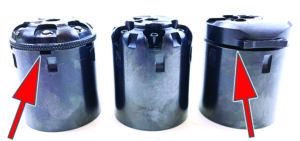
The Taylor’s cylinder chambers are easy to load. Tolerances are close on the backplate, and it needs to be aligned properly to mate to the cylinder. Since the hand sticks out inside the cylinder frame, the shooter needs to align the hand with one of the firing-pin cut outs, then rotate the cylinder clockwise to allow the hand to slip into the ratchet. This takes practice because it is easy to push the cylinder in too far, which results in removing the cylinder and starting over.
With the rear of the cylinder mated to the hand, the front of the cylinder fell into place, and the cylinder pin could be inserted and the loading lever locked. With the cylinder installed, we would align a chamber with the bore so the hand and ratchet were in sync and the bolt at the bottom of the cylinder window was locked into a notch in the cylinder. At this point with a loaded cylinder, you can start shooting.
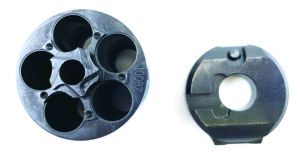
We noticed that if we cocked back the hammer slow or fast, the cylinder always rotated into battery and a chamber aligned with the bore. But a ring started to form around the cylinder, and that indicates the bolt timing is slightly off. The Taylor’s cylinder fired every time we dropped the hammer. Best group with 45 Colt ammo measured 1.3 inches with Sellier & Bellot, and with the Choice 45 Schofield, the best group measured 1.05 inches. Across all ammo, the average ranged from 1.39 to 2.95 inches, which is fine for plinking and Cowboy Action Shooting.
Loading the Kirst cylinder was the same, except there are only five chambers. The backplate of the ring is also cut out to allow the hand to clear the backplate. The Kirst cylinder literally drops into the cylinder frame with no fuss or wiggling. Once the cylinder was installed and the hammer cocked slowly, the cylinder did not completely align nor lock in place. We had numerous misfires, and when the cylinder was removed, the firing-pin hits to the primer were off center. Some rounds did fire, and we experienced splashing of lead. The cylinder was not coming into full battery. When the hammer was vigorously cocked, the cylinder rotated properly and came into full battery with the bolt locking and no lead splashing upon firing. The best group measured 1.11 inches with Magtech 45 Colt. The best with the 45 Schofield measured 1.90 inches. Across all ammo, groups averaged 1.81 to 3.11 inches.
Gun Tests Grade: A-
$285
The Kirst cylinder was fast and easy to install, even though it had a tight fit. It worked perfectly when we aggressively cocked the revolver. The timing needed to be tweaked.
The heft of the 1858 New Army helped to absorb recoil, and we did have the second knuckle of our middle finger rapped by the rear of the trigger guard with the 45 Colt loads. To eject empty cases from the chambers, we used a pen or screwdriver.
After the range session, we contacted Kirst about its Uberti cylinder, and they said it was probably a timing issue, which can be adjusted yourself, or by a gunsmith. Sometimes batches of Italian guns run wide on the tolerances, but nothing that can’t be fitted with slight adjustments, they explained. In the box with the Kirst cylinder was a troubleshooting guide for 1858 Remingtons. The solution was to slightly bend the hand toward the center of the gun so the hand made complete contact with the ratchet. That solved our problem, and we were back in business.
Our Team Said: We liked the traditional long-barrel Uberti Remington and thought its accuracy was good for most uses. The Taylor’s cylinder worked without issue, but it can be tedious to install. Choose this one if you don’t want to tinker with your revolver’s timing.
The Kirst cylinder is fast to install, but it needed a timing tweak. We liked the look of the Kirst cylinder, but wish it held six rounds instead of five. Choose the Kirst for fast cylinder swaps, just make sure the timing is right.
Taylor's Conversion Cylinder 45 Long Colt
| Magtech 250-grain LFN | Uberti 1858 New Army | Taylor’s & Co. 1858 Remington 5.5 in. |
| Average Velocity | 789 fps | 758 fps |
| Muzzle Energy | 346 ft.-lbs. | 342 ft.-lbs. |
| Smallest Group | 2.06 in. | 1.72 in. |
| Average Group | 2.95 in. | 1.82 in. |
| Sellier & Bellot 250-grain LFN | Uberti 1858 New Army | Taylor’s & Co. 1858 Remington 5.5 in. |
| Average Velocity | 901 fps | 810 fps |
| Muzzle Energy | 451 ft.-lbs. | 364 ft.-lbs. |
| Smallest Group | 1.31 in. | 1.15 in. |
| Average Group | 1.39 in. | 1.80 in. |
Taylor's Conversion Cyhlinder 45 Schofield.
| Choice Ammunition 200-grain RNFP | Uberti 1858 New Army | Taylor’s & Co. 1858 Remington 5.5 in. |
|---|---|---|
| Average Velocity | 855 fps | 845 fps |
| Muzzle Energy | 325 ft.-lbs. | 317 ft.-lbs. |
| Smallest Group | 1.05 in. | 2.18 in. |
| Average Group | 1.79 in. | 2.50 in. |
Kirst Konverter Conversion Cylinder 45 Long Colt.
| Magtech | Uberti 1858 New Army | Taylor’s & Co. 1858 Remington 5.5 in. | ||
| Average Velocity | 725 fps | 780 fps | ||
| Muzzle Energy | 292 ft.-lbs. | 340 ft.-lbs. | ||
| Smallest Group | 1.11 in. | 1.92 in. | ||
| Average Group | 1.81 in. | 2.08 in. | ||
| Sellier & Bellot 250-grain LFN | Uberti 1858 New Army | Taylor’s & Co. 1858 Remington 5.5 in. | ||
| Average Velocity | 859 fps | 882 fps | ||
| Muzzle Energy | 410 ft.-lbs. | 432 ft.-lbs. | ||
| Smallest Group | 2.07 in. | 2.65 in. | ||
| Average Group | 3.11 in. | 2.69 in. |
Kirst Konverter Conversion Cylinder 45 Shofield
| Choice Ammunition 200-grain RNFP | Uberti 1858 New Army | Taylor’s & Co. 1858 Remington 5.5 in. |
|---|---|---|
| Average Velocity | 875 fps | 861 fps |
| Muzzle Energy | 340 ft.-lbs. | 329 ft.-lbs. |
| Smallest Group | 1.90 in. | 1.27 in. |
| Average Group | 2.38 in. | 1.54 in. |


























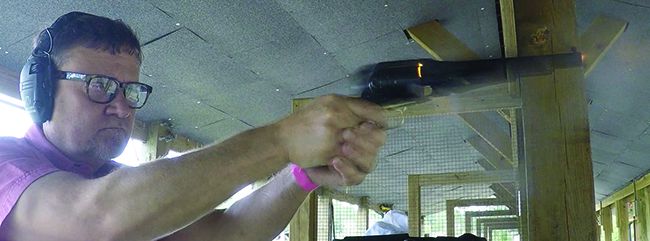
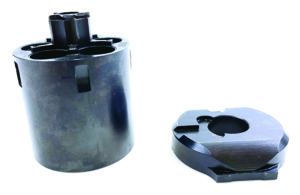


Very interesting article about the conversion cylinders for the 1858 Remington replicas. As a young Sailor many years ago I had one, as well as an original Colt 1860 Army. That old Colt would shoot, even though it looked as if it had fought through the entire Civil War! I used the Colt almost every Saturday. Until one day she spit a round ball back at me, ricocheting from an old oak plank! The ball hit me in the chest, leaving a sore bruise for several days. I retired her to wall-hanger status. Eventually, someone took her, green felt frame and all. All my guns now are 9MM or .38 Special. But I still enjoy reading about the old ones!